Finnish Army Artillery of the 1920’s was largely inherited from the old Tsarist Russian Army. During World War One Russia built several fortification lines in Finland as forward defences for the capital, which at that time was St. Petersburg (rather than Moscow). The fortification lines needed artillery and as Russia had a serious shortage of modern artillery they were mostly equipped with older guns. During the Finnish Civil War of 1918 large numbers of these guns saw battle with the both sides. In less then five months the Finnish White Army had won the Civil War and captured all the guns which the Russian military had left behind. It was these guns, together with a small number bought towards the end of WW1 that formed the bulk of the Finnish Army’s Artillery strength through the 1920’s. There were some purchases through the 1920’s, but these were generally limited due to the budgetary constraints the Armeija was under.
In this section, we will summarise the artillery on a gun type by gun type basis, and finally take a quick look at the overall artillery strength towards the end of the 1920’s. This will serve as the prelude to a later post on the buildup of Finnish Artillery strength through the 1930’s. A separate post will cover Coastal Artillery specifically.
All photos and OTL historically accurate details in this section are used courtesy of the Jaeger Platoon Website (Kiitos Jarkko) (http://www.jaegerplatoon.net/MAIN.html – this is a great website with a mountain of detailed information and photos on Finnish weapons – you name it, it’s there, however obscure) – and of course, any mistakes are mine.
Finnish Army Artillery of the 1920’s Part I: Ex-Russian Guns with No Recoil Systems
As the heading states, these older Guns had no recoil systems. The old Russian fortification lines had needed artillery and as Russia had a serious shortage of modern artillery they were mostly equipped with older guns, which had no recoil systems. Because of this the guns demanded first building well-prepared positions with ramps and recoil-effect reducing equipment before shooting with the guns could begin. Even then their rate of fire was not usually comparable to modern quick-fire artillery pieces, which had proper recoil systems. The firing rate varied from one shot per two minutes to two shots per minute, the rate-of-fire depending calibre of the gun, ammunition, training level of crew and the equipment used with the gun.
OTL and as a point of historical interest, many of these guns were actually used in the Winter War, by which time they were in a pretty sorry state with their ammunition being well beyond it’s “use-by date”, this led to a much larger number of misfires than average. As if this was not bad enough, during the Winter War about 40 % of the remaining ammunition was old-fashioned shrapnel, which in earlier tests had proved to be quite ineffective. Ammunition used in these guns was of the bagged type – meaning that the gunpowder came in bags and was loaded separately from the projectile and primer. So the ammunition had no cartridge case of any type. Ammunition used with the 87-mm guns had only one propellant charge size (the propellant charge came in single bag), so their propellant charge size could not be adjusted.
During the Winter War some of the guns had not been equipped with wedges and other recoil dampening equipment, this led to these guns being given nicknames such as “Hyppyheikki” and “Hyppyjaakko” (Jumping Henry). The nicknames spread and became widely-used nicknames for all kinds of guns without recoil systems within the Finnish military. The stories and jokes exaggerated the “jump”, in reality with the proper equipment and techniques the guns simply rolled a bit backwards on their wheels and because of ramps returned back pretty much to their earlier position. When it comes to the opinions of Finnish soldiers concerning these guns there seems to have been two basic lines. The Finnish Military leadership and HQ’s often didn’t value the old guns too much and loosing a few of them wasn’t seen as much of a loss, while the rank-and-file soldiers using the guns or getting fire support from them were grateful for the little they had.
Example of a typical Finnish joke concerning guns without a recoil system:
Q: Why does “hyppyheikki” need two observers?
A: The first observer checks where the projectile goes and the second observer checks where the gun goes.
Anyhow, back to the history…….
87 K/77 (87 mm Model 1877 / Polevaja lehkaja pushka obr. 1877 g.)
This was a Russian-built 87mm gun firing bagged ammunition that had been manufactured in the 1870’s. It fired a 6.8kg shell and with a range of approx. 6km. These were captured and used in large numbers in the Finnish Civil War of 1918, after which they were used as a training weapon in the 1920’s before being retired. Both versions (standard and cavalry) had been designed as horse-towed. In 1918 a large number of these guns had been positioned in fortifications which the Russians had built in Finland to guard against a possible German attack. At the end of 1918, the Finnish Army had 144 of these guns in use. After the Civil War ended, the guns were found to be simply too old and too worn for further military use.
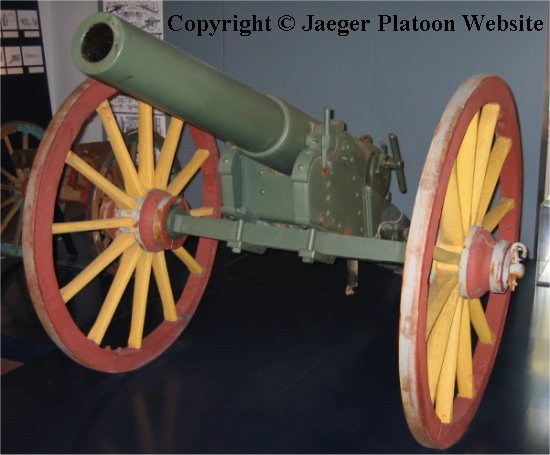
87 K/77
87 K/77. Within the Finnish military the yellow colour usually marks the weapon as “for training only”. Notice that the muzzle of the gun barrel has no bulge to strengthen it, unlike in French guns of the same era. (Photo taken in Tykistömuseo).
Even the Suojeluskunta artillery units of the 1920’s, which used artillery of questionable quality, would not accept these guns for use. In the 1920’s the Finnish Army used a small number of them for training but after that most of them were scrapped while a small number were used in monuments. (OTL: As a point of interest, the last ones were not removed from Finnish Army warehouses until the 1950’s). ATL – unchanged.
87 K/95 (87 mm Model 1895)
This was a Russian-built 87mm gun using bagged ammunition manufactured in 1895 and firing a 6.8kg shell with a range of approximately 6km. These guns were fitted with an early recoil system (a flexible spur added in the end of the box trail which removed some of the worst kick of the recoil, but not enough) and were also fitted with another innovation, a simple traverse setting system allowing sideways aiming to be adjusted 4 degrees without moving the gun. The guns also had the de Bange type screw breech (as in the Obuhov-manufactured m/1877) and some were fitted with gun shields. During World War 1 the Tsarist Russian military had brought a large number of these guns to Finland. A large number were then captured during the Civil War and a further 12 were bought from Germany in 1918. Along with the older model 87 K/77 versions of the same caliber, they formed the back bone of the Finnish White Army artillery during the early part of the Civil War.
The Finnish Arny’s artillery inventory from late November 1939 includes 47×87 K/95 and 33×87 K/95-R guns. These had already seen plenty of use with the Finnish military with two guns having been used by Finnish volunteers in the Aunus Expedition of 1919 and another four guns having been sold to the newly established Estonian State where they were used by the 2nd Battery of the Finnish volunteer unit, Pohjan Pojat who were fighting in Estonia against the Bolsheviks. After the Estonian War of Liberation ended the Finnish volunteers left their four guns to the Estonians. However, the large majority of these guns emained in Finland, where they were transferred to the Coastal Artillery. However, some were soon transferred to the Suojeluskunta (Civil Guard) artillery, which used them as training weapons up until World War 2. During the Winter War about 50 of these were used by Coastal Artillery Units. ATL – unchanged.
107 K/77 (107 mm Model 1877, artillery battery version)
This was a Russian-built 107mm gun using bagged ammunition manufactured in 1877 and firing a 12.5kg shell with a range of approximately 5.3km. These guns had originally been designed and manufactured for Tsarist Russia by Krupp, but were later manufactured by the Obuhov factory in Russian. Because of this, during WW1 the Russian military usually issued the gun only as a direct fire gun, typically to coastal defence in such positions which allowed the guns to use direct fire in defending harbours and beaches.
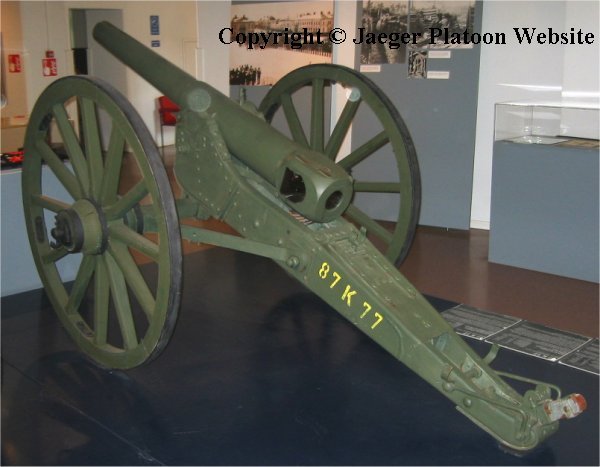
107 K/77 Field Gun
107 K/77 Field Gun. The Breech block of this gun seems to be missing. Notice the very simple structure and that the muzzle of gun barrel has no bulge ring, unlike in French guns of the same era. (Photo taken in Tykistömuseo).
The Finnish Army captured 102 of these guns in 1918. Between the Civil War and the Winter War these guns saw some limited use, but by the Winter War the guns and ammunition for them was in very bad shape – and the number of fuses available for their ammunition was limited. OTL, some 80 of them were used in the Winter War. ATL, these were scrapped in the late 1930’s.
107 K/77 Piirk (107 mm Model 1877, siege gun version)
Tsarist Russia had selected a caliber of 107mm for the Army’s medium guns. For the Model 1877 guns, there were two versions – the Field Gun Version and the Siege Gun version. The Siege Gun version is easy to identify due to its high gun carriage and long barrel, with the wheels being made from wood with steel hoops. They fired an 8.3kg shell with a range of 8.3km.
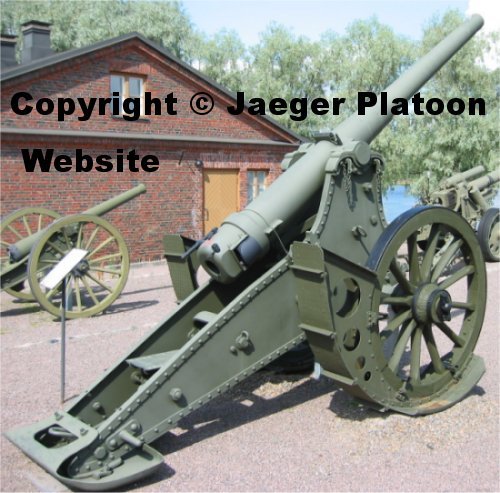
107 K/77 Piirk cannon
107 K/77 Piirk cannon. Notice the equipment around the wheels used to reduce recoil. Also notice the Krupp horizontal sliding block breech, box trail open from the top and metal plate under end of the trail. (Photo taken in Tykistömuseo).
Obuhov seems to have been the sole manufacturer of this gun. The Finnish White Army captured either 47 or 57 of these guns (depending on sources) with most captured in Helsinki and the rest in Viipuri. After the Civil War, these guns saw little use but with large amounts of ammunition in warehouses when the Winter War started, they were brought back into service. ATL – brought back into use for Coastal Artillery fortifications.
152 K/77-120p (152 mm Model 1877, 120-pud barrel version)
The Tsarist Russian military had two versions of the 152-millimetre siege gun m/1877 and this was one of them. The Russians separated the two versions by the weight of their barrel using a Russian unit of weight measurement – the “pud”, which was about 16.38 kg. So, basically this 120-pud version had a notably shorter barrel than the other (190-pud) version. The gun had a box-trail, wooden wheels with steel hoops and the horizontal sliding block breech typical of large calibre Russian siege guns of the era. The trail used included a primitive recoil reduction mechanism. It seems that the Russian Obuhov and Perm factories were the only manufacturers of these guns.
The Finnish White Army captured 102 of these guns in 1918, but none were used in the Finnish Civil War. Immediately after the Civil War six of these guns were issued to three artillery batteries (with 2 guns each), which were created at Äyräpää, Metsäpirtti and Sakkola near the border on the Karelian Isthmus. The artillery batteries were to be crewed by local Suojeluskunta (Civil Guard) units if needed and existed until 1921. The guns were also used as training equipment in Heavy Artillery Regiments until the early – mid 1920’s.
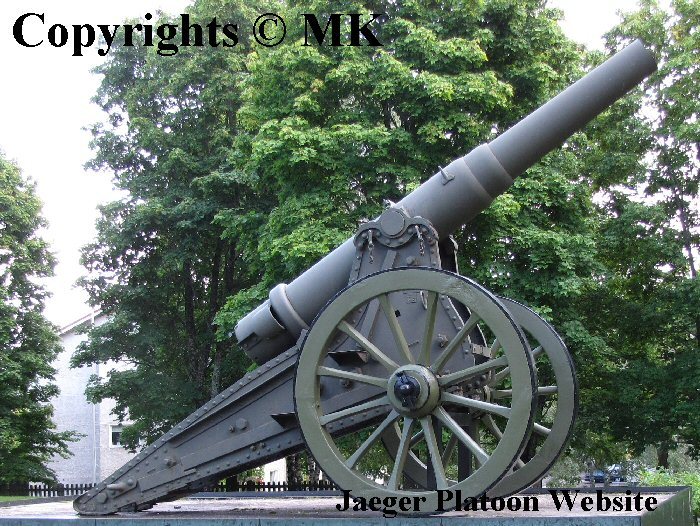
152 K/77-120p field gun
OTL: In the Winter War 12 guns were used by Heavy Artillery Battalion 5. During the Continuation War they saw some use with the Syväri Fortification Artillery Battalion 1. When Finnish troops retreated from the river Syväri/Svir in June 1944, the Battalion still had 23 of these guns. As the guns were so worn-out, outdated and difficult to transport, the Finnish troops left them behind. The Finnish military found these guns to be accurate and their projectiles powerful, but transporting these heavy old guns was problematic.
ATL: Placed in prepared positions within the Karelian Isthmus defences and fired until ammunition ran out or positions overrun, in either case they were destroyed in place.
152 K/04-200p (152 mm cannon model 1904, 200-pud barrel version)
This was the last, heaviest and most modern of the Russian 152-mm siege guns. The gun was manufactured by the Russian Obuhov factory and unlike earlier heavy siege guns had a de Bange screw breech. The wheels were the usual ones with wooden spokes and steel hoops and the gun also had the usual box trail, but also had a built-in system which somewhat reduced its recoil. The recoil reduction system was similar to ones used in Russian heavy mortars at that time and used a hydraulic axle anchored to the ground for dampening the recoil. The 152 K/04-200p fired a 41.1 kg shell with a range of 11.2km.
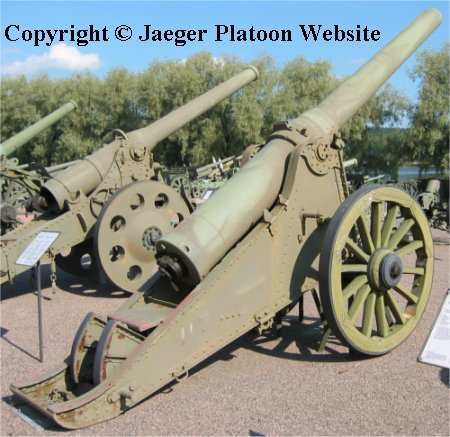
152 K/04-200p in the yard of the Finnish Artillery Museum
The Finnish White Army captured four of these guns at the beginning of the Civil War, but due to the size and weight, transportation was a problem. All four guns were later used in the Winter War, where they were issued to the Coastal Defence of Lake Ladoga, which used them to for fire support against Soviet forces. OTL, two of the guns are now in Finnish museums. ATL: issued to Coastal Defence of Lake Ladoga, where they were used for fire support.
152 K/77-190p (152-mm cannon model 1877, 190-pud barrel version):
This was the other version of the 152-mm Russian m/1877 siege gun – the version with the slightly longer and considerably heavier barrel. These two versions had been named according to barrel weight, which was expressed in the Russian weight measurement “pud” (about 16.38 kg). As usual the gun had a box trail and wooden wheels with steel hoops. The gun also had a somewhat ineffective built-in recoil reduction system. 115 guns were captured in 1918, but the Finns never used any in battle. The Russian Obuhov and Perm factories had manufactured all of these captured guns. The 120-pud barrel version not only had better range because of more modern projectiles, but it also was handier and weighted less, so the Finnish military favoured it instead of this 190-pud barrel version.
ATL: issued to Coastal Defence of Lake Ladoga, where they were used for fire support.
229 M/77 (229mm Mortar Model 1877)
This was the 9-inch Russian coastal mortar model 1877. Using bagged ammunition, the Mortars fired a 122.9-135kg shell with a rage of 7.2-7.4kms. The mortar was designed for coastal forts and was anything but mobile. Six mortars were captured in 1918, but were not used in the Civil War and were placed in storage.
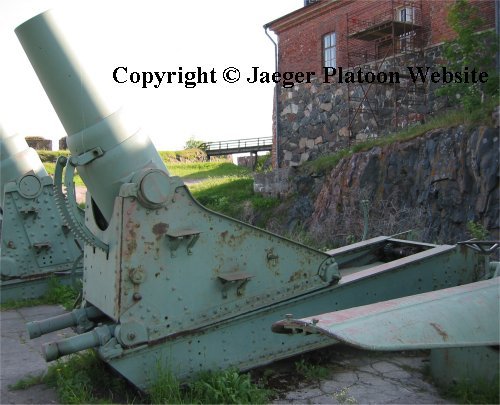
229 M/77 (229-mm mortar model 1877):
279 M/77 (279-mm mortar model 1877)
This was the Russian 11-inch coastal mortar. Similarly to its 9-inch cousin it was designed for coastal fortresses and moving one to another fire position demanded a laboured process of first dismantling the mortar and its fortification carriage, then assembling it again in the new position. The mortar had a wedge-block breech. Four or five of these mortars were captured in 1918. OTL, the only remaining mortar is nowadays in Suomenlinna.
ATL: all M/77 Mortars used to reinforce Coastal Artillery Fortifications.
Finnish Army Artillery of the 1920’s Part II: More Field Guns
76 K/00 (76 mm Model 1900 / Trehdjumovaja poljevaja pushka obr. 1900)
During the Civil War, the Finnish White Army used only one of these guns, while the Red Guards used them in rather substantial numbers. The total number of guns captured in 1918 was 34, but only 21 of them were in somewhat usable condition. The gun fired shells of 6.6-6.7kgs with a range of 6.7-8.8 kms and with a variety of ammunition types (HE, AP, AP-T, APHE-T, shrapnel, incendiary). This gun, designed by Russian General Engelhardt, was the first modern Russian designed field gun. The structure of the recoil mechanism was that which one could expect from mountain gun. Somewhat unusually the parts of recoil system had been built into the gun carriage. The gun had a hydro buffer and a bar was used to transmit the rest of the recoil energy to the recuperator, which consisted of steel and rubber plates.
Between 1901 – 1903 some 2,400 were manufactured in the Putilov, Sankt Peterburg, Obuhov and Perm artillery factories. During the Russo-Japanese War of 1904 – 1905 this gun saw large-scale use with the Russian Army. The gun had the typical wooden wheels with steel hoops, screw breech, box trail and seats for two crewmembers to sit during transport. Originally the gun had only open sights (and thuse was suitable only for direct fire use), but later a simple optical sight was added. The gun had wheel anchors, so slight corrections to aim were often needed between shots.
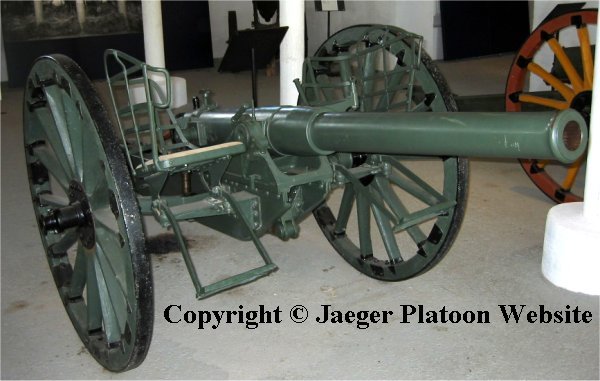
76 K/00 field gun
76 K/00 field gun. Notice the recoil system build inside the gun carriage and the frame seats on both sides of the barrel. (Photo taken in Tykistömuseo).
OTL: Of the 21 usuable guns, during the Winter War 16 were used by the field artillery and the rest were used for training.
ATL: Unchanged.
76 K/02 (76 mm cannon model 1902 / 3-djujmovaja pushka obr. 1902)
During World War 1 this gun was the most numerous field artillery piece used by the Tsarist Russian Army. After World War 1 outside of Russia/Soviet Union the largest user of these guns was probably Poland, where over 400 guns were from 1926 on modified to use the same 75-mm ammunition as the French model 1897 and renamed 75mm wz. 02/26. Other countries also using these guns included Lithuania and Romania (Romania also had their guns modified to 75-mm field gun model 1902/36). In the Soviet Union the large majority of these guns were modified in 1930’s to the 76,2 mm Pushka obr. 1902/30 g. but a relatively small number of unmodified guns also saw use with the Soviet Red Army during WW2.
This gun was based on earlier designs of the improved 76 K/00 by General Engelhardt and designed in the Putilov factory by L.A. Bishjakov, K.I. Lipinskij and K.M. Sokolovskij. Some ideas also seem to have originated from the French 75-mm field guns model 1897. The gun had a box trail, wooden wheels with steel hoops, a recoil system with hydro buffer and a spring recuperator under the barrel, a screw breech and no wheel anchors. Early versons didn’t have a gun shield, but had seats for two crew-members instead. Later a straight vertical gun shield with foldable upper and lower sections was introduced and the seats were removed. Several sight models existed, the last and most common being Goertz dial sight. Because of the recoil system and lack of wheel anchors some of the recoil energy was not always removed – in these cases the aim of the gun had to be corrected after each shot.
How well trained the crew was and if the gun was well laid had a large impact on the practical rate-of-fire – which varied between 8 – 15 shots/minute. When compared to the standard of that time, the French 75-mm model 1897 the gun wasn’t as effective, but it was also easier to manufacture.
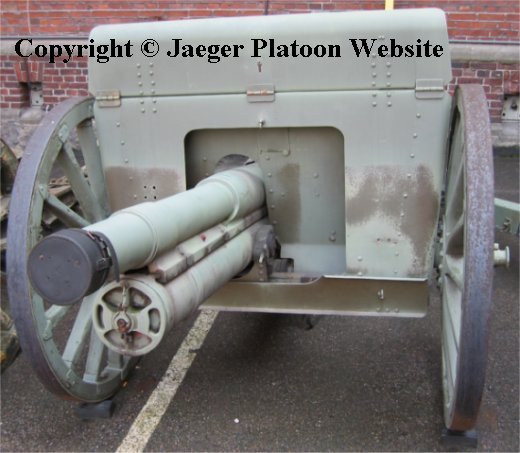
76 K/02 field gun
76 K/02 field gun with upper shield part opened and lower part folded. Notice gun shield structure. (Photo taken in yard of Sotamuseo).
The Finnish White Army captured 159 of these guns in 1918 and bought an additional 20 from Germany. They fired a 6.3-6.5kg shell, with a range of 7.9-10.6 kms and with a variety of ammunition types (HE, AP, AP-T, APHE-T, shrapnel, incendiary). Maximum range in direct fire use was about 4 kilometres. Originally the gun had been designed to be horse-towed, but it could also be towed with trucks or transported on the motor truck body. Maximum speed when horse-towed was around 10 km/h. When the gun was towed with horses, a limber carrying 40 shots was used with it. After the Civil War the 76 K/02 was selected as the main light field gun for the Finnish Army for a very simple reason: It was the most numerous of the captured modern field guns and readily available for free.
In 1931, Transbaltic Oy exchanged a number of older guns for eleven 76 K/02 field guns.
ATL: Finland also bought 54 76/K02 guns from Germany in early 1939 (OTL, this occurred in late 1940) bringing the total number in service at the start of the Winter War to 244.
107 K/10 and 107 K/13 (107 mm cannon model 1910 and 107 mm cannon model 1913)
This 107-mm cannon was designed by the French Schneider factory for Russia and it was manufactured in both France and Russia. The gun was intended as a replacement for the old 107-mm and 152-mm heavy guns, which lacked a recoil system. The Russian manufacturers were the St. Petersburg artillery factory of Obuhov and the Putilov Factory. The cannon was modern for its time and the French military ordered their own 105-mm calibre version with a more durable (and heavier) gun carriage in 1913. This also lead to development of the 107 mm Canon mle 1913, which was basically the 107-mm Russian field gun with an improved gun carriage. Unusually for cannons of such a large calibre at this time the gun used fixed ammunition (manufactured with two propellant charge sizes). Otherwise the gun was typical with a box trail, screw breech, wooden wheels with steel hoops and a gun shield. Rate of fire was about 5 – 6 shots/minute. Unlike the French 107 mm Canon mle 191, the recoil system located under barrel was quite conventional.
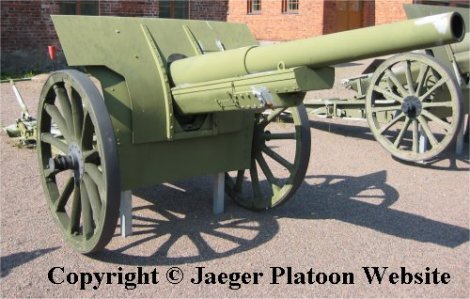
107 K/10 field gun. (Photo taken in Tykistömuseo).
The Finnish Red Guards used a few 107 K/10 guns during the Civil War and, as usual, the Finnish White Army captured some of them (two guns in Helsinki and one gun in Viipuri). However, in this case the number of intact or repairable captured guns was quite small. Once the situation had settled down Finland purchased more from France (four guns), Poland (two guns) and Latvia (two guns) increasing the total number in service to eleven. Two of the guns were French-made 107 mm Canon mle 1913 aka 107 K/13, while the other the nine were Russian-made 107 K/10. In the 1920’s they served as training equipment for the Finnish heavy artillery units, being the only heavy field guns in Finnish use at that time.
Finnish Army Artillery of the 1920’s: Howitzers
Being capable of high-trajectory fire and also very mobile, light howitzers were ideal for Finnish terrain and climate. On the other hand World War 1 era light howitzers had only short range, which seriously limited their effectiveness – and in the 1920’s, Finland had only a very small number of ex-WW1 Howitzers in service.
150 H/14j (150 mm howitzer model 1914, Japanese / 15 cm Meiji 38 howitzer)
In the Civil War, the Finnish White Army captured 12 of these howitzers. According to some sources the Finnish Red Guards and Russians had used them against the Finnish White Army before they were captured, but according to another source they were captured without battle use either at the Huopalahti Warehouses of the Russian Army or from the Russian Garrison in Södervik (Suvilahti) – both places are in the Helsinki area. Either way the White Army didn’t use them during the Civil War. These dozen heavy howitzers might not see much but considering the weapons situation of the Finnish military in the 1920’s they were very important – all other heavy howitzer models in Finnish use at that time were even less numerous.
Being the only howitzers numerous enough to arm a whole Heavy Artillery Battalion (of 12 guns/howitzers) they became the main training weapon for Finnish heavy field artillery before World War 2. In the late 1930’s four of the howitzers were used by the Civil Guard (Suojeluskunta) artillery units for training, while eight remained with the Heavy Artillery Regiment (the principal heavy artillery training unit of the Finnish Army). The training use took its toll – ammunition for them was in short supply before the Winter War.
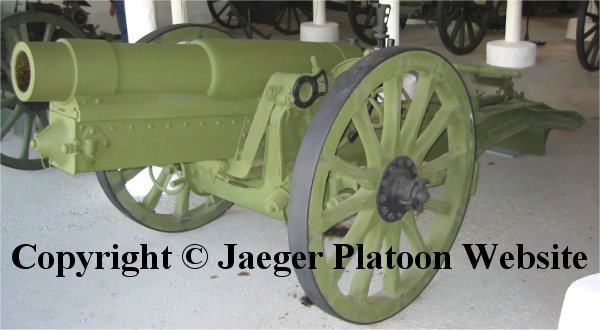
150 H/14j heavy howitzer. (Photo taken in Tykistömuseo).
This howitzer was the Krupp design known as 10,5 cm sFH 02 in Germany, manufactured in Japan as the Meiji 38 (model 1905) and fired a 40.5-43.0kg shell with a range of 7.2kms. The Japanese military bought the first of these howitzers from Germany during the Russian-Japanese War of 1904 – 1905 and later manufactured the howitzer under license. The howitzer remained in Japanese until the end of the World War 2. During World War 1 the Russian military had a shortage of artillery weapons, so Russia bought these howitzers from Japan. In fact, it is likely, that the model 1914 of the Finnish name for this howitzer model may originate from the year the Russians bought them.
Structure-wise this howitzer is pretty typical of the heavy howitzer of its era. It had the usual box trail with a hole in middle of it for more elevation, a recoil system with hydraulic/spring buffer/recuperator below barrel and wood wheels with steel hoops. It also had a screw breech and a dial sight but no gun shield. Ammunition was cartridge seated type and only HE-ammunition seems to have been used in Finland. The Finnish military used HE-projectiles with both TNT and ammonal (ammonium nitrate based high explosive) filling, these ammunition types were probably of Russian origin (since they were included in Finnish artillery manuals from 1925).
152 H/10 (152 mm howitzer model 1910 / 6 dm polevaja gaubitsa sistemy Schneidera)
In the Civil War the Finnish White Army captured nine of these howitzers. Most were captured in Helsinki and the rest in Viipuri. None saw battle use during the Civil War. Before World War 2 they served as training equipment for the heavy Field Artillery of the Army. The Finnish army used only one kind of ammunition with them: high explosive (HE). The ammunition was cartridge seated type with four propellant charge sizes. The usual HE-projectile weighed 43.5-kg, but according to the 1925 manual some HE-projectiles manufactured for the 152-mm Canet coastal gun could be used with these howitzers. They had a range of 7.7-6.0 kms.
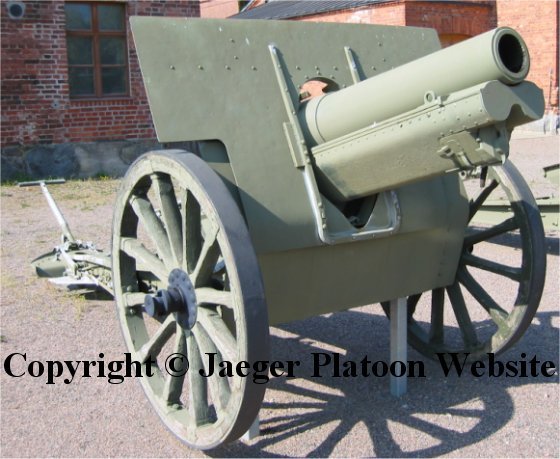
152 H/10 heavy howitzer. (Photo taken in Tykistömuseo).
This howitzer was a Schneider design manufactured under license in Tsarist Russia and presumably manufactured by Putilov. The howitzer was in large-scale use with the Russian Field Artillery during World War 1. This howitzer is related to the 155-mm French howitzers that Schneider introduced during WW1. The howitzers were still in Soviet use during WW2 and the Germans captured some. Technically the howitzer was typical of its time: Box trail (with a hole in the middle), a breech mechanism with screw breech and recoil mechanism with hydraulic/pneumatic buffer/recuperator below the barrel. The gun shield had an inclined lower part and a hole for direct fire aiming with dial sight. The original wheels were wood with steel hoops, but later these were replaced with steel wheels covered with rubber tires. The howitzers were suitable both for motorised towing and towing with horses.
152 H/15 and 152 H/17 (152 mm howitzer model 1915 and 1917 / Canon de 155 C Mk 1915 & Mk 1917 Schneider (6”)
Four 152 H/15 and eight 152 H/17 howitzers were bought from France in the late 1920’s. They fired a 43.6 kg shell with a range of 11.2kms. After WW1 French factory Schneider was ready to manufacture its WW1 era howitzers in various calibre for export. These howitzers had the same basic structure as in Schneider howitzer models 1915 and 1917, but were ordered in 152.4-mm calibre for ammunition compatibility with captured Russian howitzers. The 152 H/15 used the same cartridge cases for their cartridge-seated ammunition as the Russian 152 H/10’s captured in 1918. Twelve of these howitzers were delivered to Finland: Four 152 H/15 and eight 152 H/17. They arrived in several batches over 1925 – 1926 and 1929. In Finland all the twelve howitzers were used together and usually referred to collectrively as the 152 H/15/17.
Both howitzer models had the usual box trail, gun shield curved from its lower part (typical to Schneider designs), screw breech and recoil system with hydraulic buffer and pneumatic recuperator below barrel. Both howitzers also lacked wheel brakes. Barrels used in both howitzers was similar, but the ammunition was different (cartridge-seated for 152 H/15 and bagged for 152 H/17). The wheels were also different: Originally the 152 H/15 had wood wheels with steel hoops, these were later replaced with wheels which had rubber tires, while the 152 H/17 had wood wheels with steel hoops covered with a solid rubber layer. The 152 H/15 had also been designed as horse-towed while the 152 H/17 was more suitable to motorised towing. Before WW2 the howitzers were used as training equipment. In 1928 Italian Pavesi tractors were acquired and used as their towing vehicles.
Summary: Table of Finnish Artillery in the 1920’s
87 K/77 (87 mm Model 1877) – 144 (scrapped in the 1920’s)
87 K/95 (87 mm Model 1895) – 80
107 K/77 (107 mm Model 1877 – 80 (scrapped in the late 1930’s)
107 K/77 Piirk (107 mm Model 1877, siege gun version) – 47
152 K/77-120p (152 mm Model 1877, 120-pud barrel version) – 102
152 K/04-200p (152 mm cannon model 1904, 200-pud barrel version) – 4
229 M/77 (229mm Mortar M1877) – 6
279 M/77 (279-mm Mortar M1877) – 4
76 K/00 (76 mm Model 1900) – 21
76 K/02 (76 mm M 1902) – 179 (244 on outbreak of the Winter War)
107 K/10 and 107 K/13 (107mm M1910 and M1913) – 11
150 H/14j (150mm howitzer model 1914) – 12
152 H/10 (152mm howitzer M1910) – 9
152 H/15/17 (152mm howitzer M1915 and 1917) – 12
OTL (Original Time Line): This is pretty much what Finland went into the Winter War with in the way of Artillery – about 500 guns, many of them obsolete. Makes you think a bit doesn’t it.
ATL (Alternative Time Line): Thanks to the Finnish Procurement Program of the 1930’s, things will be somewhat different
 Copyright secured by Digiprove © 2013 Alternative Finland
Copyright secured by Digiprove © 2013 Alternative Finland

